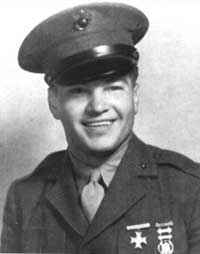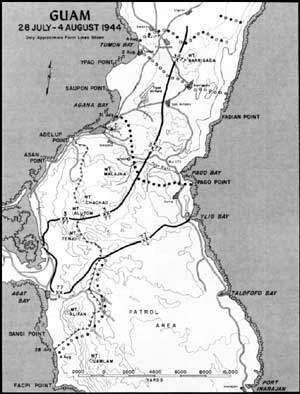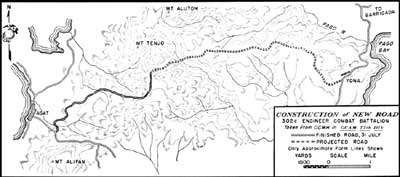| Marines in World War II Commemorative Series |
|
LIBERATION: Marines in the Recapture of Guam by Cyril J. O'Brien The Attack North III Corps's Geiger knew Obata's probable route of retreat and drew up a succession of objectives across the island which would incrementally seize all potential enemy strong points. Jump-off for the drive north was 063031 July with the 3d Marine Division on the left and the 77th Infantry Division on the right, dividing the island down the middle. The Marine zone would include the island capital of Agana, the Japanese airfield at Tiyan, Finegayan, and the shores of Tumon Bay. The 77th would have Mount Barrigada, Yigo, and Mount Santa Rosa in its zone. The 1st Marine Brigade relieved the 77th Division of the defense of the southern portion of the FBHL and would continue to patrol the southern half of Guam. As the Corps attack moved northward and the is land widened, the brigade would eventually take part in the drive to the extreme north coast of the island.
The 3d Division reached Ordot in the center of its zone where Obata had directed some of his survivors. The 3d Battalion, 21st Marines, ran into them and one of their pillboxes, which the Marines thoroughly gutted. The Americans also accounted for 15 infantrymen and two light tanks which were the targets of M-1s and bazookas. The honor of liberating Agana fell to the 3d Battalion, 3d Marines. The riflemen entered the town’s ruins treading carefully, sizing up the stark, dusty building walls for snipers. A few enemy riflemen emerged from behind concrete outcroppings then dropped back into eternity. The Japanese guards were stragglers, the wounded, or a few foolish enough to stay. In one house, a Marine opened a closet to reveal a Japanese officer, sword in hand. The Marine slammed the door, riddled it with an automatic rifle, and didn't bother to look again. The once-beautiful old Plaza de Espana was in American hands 15 minutes after the town was entered. By noon it was secured. The 1st and 2d Battalions, 3d Marines, moved along to the critical Agana-Pago Road. At 1350 the 21st Marines was right up there with them after the few engagements with pillboxes, snipers, and tanks. By 1510, Colonel Craig's 9th Marines on the division's right was partially across the road and seized the remaining portion of that highway in its sector on the next day. Hardsurfaced, with two lanes across the midriff of the island, the Agana-Pago Road would prove critical in winning the battle of Guam. Leaving Agana and its historic rescue of the capital, the 3d Battalion, 3d Marines, under Major Royal R. Bastian, Jr., who had taken command when Lieutenant Colonel Houser was wounded on 22 July, moved on with relative ease. Before dusk the battalion had seized 1,400 yards of other critical roads and trails which led to strategic and defended strongpoints of Finegayan and Barrigada.
General Turnage got well within striking distance of the Tiyan airfield and the little town of San Antonio, on the 31st, but the next day, 1 August, his advance was seriously slowed by mines. It took the cool skill and slow and steady hands of the bomb disposal specialists of the 25th Naval Construction Battalion and the 19th Marines' engineers to reduce those obstacles. Students of the battle and those who were there consider the taking of the cross-island Agana-Pago Road as a major factor in guaranteeing the success of the drive northward. Its capture solved a host of logistic problems, for the 77th particularly. The Army division, for example, had no roads heading north initially in its zone of advance and needed such a road over which it could supply its troops as they came down out of the hills and cut their way through the jungle. Frontline troops in the Army zone were soon running low on supplies, especially water. General Bruce promised his people a hot breakfast as soon as they and the Marines could give him the road. Trucks were soon thick on the road even while SeaBees and engineers were enlarging and repairing it.
The 77th had moved out on schedule just after daylight on 31 July, with the 307th Infantry in the advance, followed by the 305th. As was the situation facing the 3d Division, enemy resistance to the Army advance was negligible. Within two hours, both Army regiments had secured the cross-island road in their zones. The 307th rescued 2,000 Guamanians in the detention camp at Asinan. Unopposed, the 77th by noon of 1 August was across the Pago River. Residents of the area said the Japanese had left in a hurry for Barrigada, a destination where III Corps intelligence already anticipated the enemy would hold up. The jungle-covered mountain there, 674 feet high, dominated the area. General Bruce assigned the capture of Barrigada to the 307th. It was to maintain contact with the 3d Marine Division on the left and push through the town, then continue about a mile to seize Mount Barrigada. The 305th to the right of the 307th would attack in the same direction east of the town and Barrigada mountain and protect to the coast. The town was in a clearing fully swept with defensive machine gun fire. In the same clearing was a much-desired well. Its capture meant the world to the parched troops.
At 0630, 2 August General Bruce dispatched a dozen tanks of the 706th Tank Battalion on a reconnaissance. As the "recon" armor turned into Barrigada town, the enemy opened up with a torrent of fire. The determined Japanese fiercely resisted the 307th when it reached the town and were equally determined to stop the 305th on the right as that regiment's assault companies tried to outflank the town. Repeated tank attacks and heavy artillery support netted only a few yards at a time, but the soldiers kept advancing and by 4 August, the 77th Division held the town, or what was left of it, its precious well, and the crest of the mountain. Captured documents and interviews with prisoners again left little doubt that the 77th Division's major obstacle would be rugged, heavily crevassed, and jungled Mount Santa Rosa. It is six and a half miles north east of Barrigada and a short distance from the ocean on the east coast. First to be addressed on the way were well-armed outposts like Finegayan and Yigo. Each promised casualties, blood, and delay. General Geiger employed the 77th to reduce Yigo and take Santa Rosa, and left the capture of Finegayan and the rest of northern Guam principally to the 3d Marine Division. He brought up General Shepherd's brigade to assist in the final drive. To protect the Force Beachhead Line, care for the Guamanians, and hunt down enemy stragglers in the south, General Geiger tasked the 1st Battalion, 22d Marines; the 7th Antiaircraft Artillery Battalion; and the 9th Defense Battalion, all under Lieutenant Colonel Archie E. O'Neil, who commanded the 9th. Before moving on, the brigade had aggressively sought out Japanese holdouts, brought the fearful Guamanians into friendly compounds, and provided security for those who chose to remain in their own homes and again work their own ranches. As late as 2 August, 4th Marines' patrols approaching Talofofo Bay on the southeast coast, came across some 2,000 natives, still apprehensive of the Japanese, who were directed to a compound which promised safety and at least minimum comforts. The Guamanian people in their own residential and farm areas could, however, still readily call upon the civil affairs sections for food, protection, medicine, and shelter. Such civil care was integral to the American occupation and was controlled by Marine General Larsen, who would head the garrison force as soon as the island was again under the American flag. During the night of 2-3 August, the 12th Marines delivered 777 rounds of harassing and interdictory fire on the roads and trails the division would encounter around Finegayan. At 0700 on 3 August, the 3d and 9th Marines moved in assault well past the Tinyan airfield. Then, about 0910 the 9th encountered a block at the cross roads approaching Finegayan village. The situation and terrain favored the Japanese with excellent fields of fire. After the Japanese position was finally overrun with tanks, Lieutenant Colonel Carey Randall, commanding 1st Battalion, 9th Marines, said that these defenses were the toughest he had faced on Guam.
That contest for Finegayan was the last major battle for the 3d Division on Guam. The Japanese made it something to remember. A 3d Division armored reconnaissance patrol headed for Ritidian Point on the northernmost point of the island ran into Japanese defenses located on the Finegayan trails bristling with anti-tank weapons and artillery pointed in the direction of the patrol. The Americans were surprised and bruised, did the Japanese some harm, but sensibly cancelled the mission. The Japanese were plenty feisty at Finegayan, and in a telling thrust dispatched two medium tanks which skirted the crossroads of the 9th Marines at Junction 177 and went up the Finegayan-Mount Santa Rosa Road. Impervious to Marine fire, the tanks shot up the area and got away. Another tank force of undetermined size then rumbled down under cover of a mortar barrage and it looked like the beginning of a counterattack. Artillery stilled that Japanese effort. The enemy tanks were driven off but survived to reappear again another day. It was in one of those typical sudden enemy attacks around Finegayan that Private First Class Frank P. Witek, with automatic rifle and grenades, raced ahead of his own tanks to destroy an eight-man Japanese position which was holding back elements of his 1st Battalion, 9th Marines. He succeeded, but was killed. He was posthumously awarded the Medal of Honor. PFC Witek's Medal of Honor Hailed Inspiring Acts' 
Private First Class Frank Peter Witek's Medal of Honor citation reads as follows: "For conspicuous gallantry and intrepidity at the risk of his life above and beyond the call of duty while serving with the 1st Battalion, 9th Marines, 3d Marine Division, during the Battle of Finegayan at Guam, Marianas Islands, on 3 August 1944. When his rifle platoon was halted by heavy surprise fire from well camouflaged enemy positions, Private First Class Witek daringly remained standing to fire a full magazine from his [Browning] automatic [rifle] at point-blank range into a depression housing Japanese troops, killing eight of the enemy and enabling the greater part of his platoon to take cover. During his platoon's withdrawal for consolidation of lines, he remained to safeguard a severely wounded comrade, courageously returning the enemy's fire until the arrival of stretcher bearers, and then covering the evacuation by sustained fire as he moved backward toward his own lines. With his platoon again pinned down by a hostile machine gun, Private First Class Witek, on his initiative, moved forward boldly to the reinforcing tanks, and infantry, alternately throwing hand grenades and firing as he advanced to within 5 to 10 yards of the enemy position, and destroying the hostile machine-gun emplacement and an additional eight Japanese before he himself was struck down by an enemy rifleman. His valiant and inspiring action effectively reduced the enemy's firepower, there by enabling his platoon to attain its objective, and reflects the highest credit upon Private First Class Witek and the United States naval service. He gallantly gave his life for his country."
|










